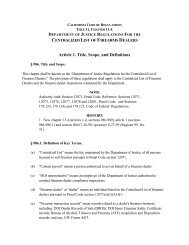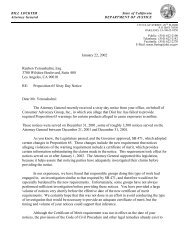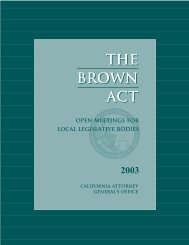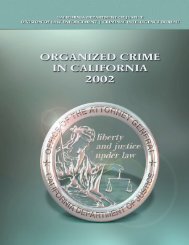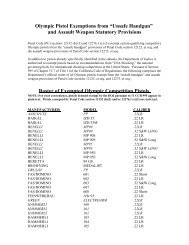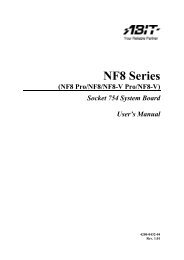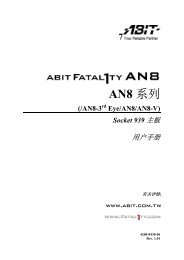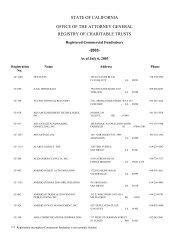Legal Rights of Persons With Disabilities - Ossh.com
Legal Rights of Persons With Disabilities - Ossh.com
Legal Rights of Persons With Disabilities - Ossh.com
You also want an ePaper? Increase the reach of your titles
YUMPU automatically turns print PDFs into web optimized ePapers that Google loves.
services, facilities, privileges, advantages or ac<strong>com</strong>modations being <strong>of</strong>fered. Additionally, the provision <strong>of</strong><br />
auxiliary aids and services is not required if it is established that it would result in an undue burden<br />
(significant difficulty or expense). Where a public ac<strong>com</strong>modation can demonstrate that barrier removal is<br />
not readily achievable, it shall make its services available through alternate methods, if those are readily<br />
achievable. Examples <strong>of</strong> alternatives are curb service or home delivery; retrieving merchandise from<br />
inaccessible shelves or racks; or relocating activities to accessible locations.<br />
(28 C.F.R. ' 36.301 et seq.)<br />
Examples <strong>of</strong> actions that may be required to be taken to remove architectural barriers include:<br />
installing ramps and curb cuts; repositioning shelves, telephones, bathroom dispensers, vending machines,<br />
display racks or furniture; adding raised markings on elevator control buttons; installing flashing alarm<br />
lights; widening doors; installing <strong>of</strong>fset hinges to widen doorways; eliminating turnstiles or providing<br />
alternative accessible paths; installing accessible door hardware and grab bars in toilet stalls; rearranging<br />
toilet partitions to increase maneuvering space; insulating lavatory pipes under sinks to prevent burns;<br />
installing raised toilet seats and full length bathroom mirrors; repositioning paper towel dispensers in<br />
bathrooms; creating designated accessible parking spaces; installing an accessible paper cup dispenser at an<br />
existing inaccessible water fountain; removing high pile, low density carpeting; and installing vehicle hand<br />
controls. (28 C.F.R. ' 36.304.)<br />
All new facilities must be designed so that they are readily accessible and usable by persons with<br />
disabilities unless structurally impracticable. If an alteration is made to a facility, then the area altered must<br />
be made accessible. Whenever a facility is altered so that an area containing a primary function is affected,<br />
the alteration must also be made in such a manner that the path to the bathrooms, telephone, and drinking<br />
fountains serving the altered area are readily accessible. However, an exception to this rule is where the<br />
alterations to the path <strong>of</strong> travel, telephones, bathrooms or drinking fountains would be disproportionate in<br />
cost and scope to the planned alteration. Also, an elevator is not required for facilities <strong>of</strong> less than three<br />
stories or which have less than 3,000 square feet per story unless the building is a shopping center or mall,<br />
pr<strong>of</strong>essional <strong>of</strong>fice <strong>of</strong> a health care provider, or unless the United States Attorney General otherwise<br />
determines. (42 U.S.C. ' 12183.) A public ac<strong>com</strong>modation is required to maintain in operable condition<br />
the facilities and equipment required to be readily accessible to and usable by persons with disabilities,<br />
although isolated or temporary interruptions in service due to maintenance or repairs are allowed. (28<br />
C.F.R. ' 36.211.)<br />
If you feel that you have been discriminated against by a place <strong>of</strong> public ac<strong>com</strong>modation, then you<br />
may file a <strong>com</strong>plaint with the United States Department <strong>of</strong> Justice or you may file your own lawsuit. (42<br />
U.S.C. '' 12188, 2000a-3(a); 28 C.F.R. ' 36.501 et seq.)<br />
B. California Laws and Regulations<br />
1. State and Local Government Buildings and Facilities<br />
California law requires that all buildings, structures, sidewalks, curbs, and related facilities,<br />
constructed with public funds and, under certain circumstances, buildings and facilities leased by state or<br />
local government, must be accessible to and usable by persons with disabilities. (Gov. Code, ' 4450 et<br />
seq.) Buildings constructed before 1968 are not required to be accessible unless structural alterations or<br />
repairs are made. If a building is altered, the area <strong>of</strong> alteration as well as the path <strong>of</strong> travel to and from key<br />
facilities (such as restrooms) serving the area must be made accessible.<br />
Complaints alleging that a public building or facility which was constructed or altered with state<br />
funds is inaccessible should be lodged with California Division <strong>of</strong> the State Architect. Complaints alleging<br />
that a public building constructed with local funds is inaccessible should be lodged with the appropriate<br />
19



